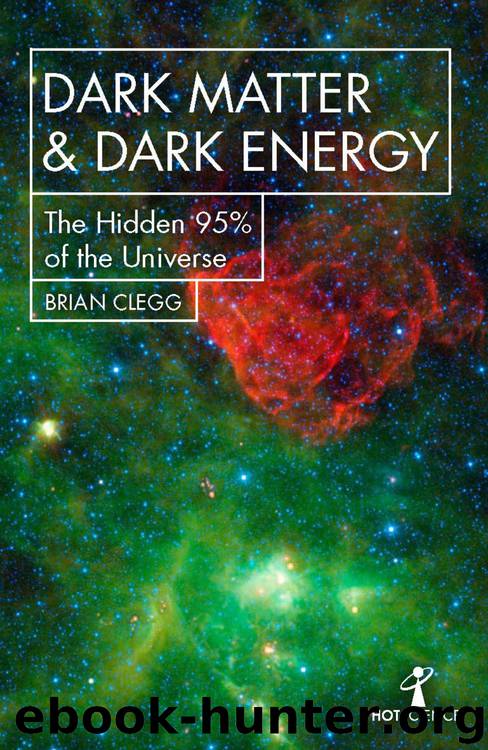Dark Matter and Dark Energy by Brian Clegg

Author:Brian Clegg [Brian Clegg]
Language: eng
Format: epub, mobi
ISBN: 9781785785696
Publisher: Icon Books Ltd
Published: 2019-09-22T16:00:00+00:00
By standard candlelight
The idea is simple. If I have two identical candles and position one further away than the other, the more distant candle will look dimmer than the nearer one. If I measure the relative brightness of the two and know the distance to the nearer candle, I should be able to work out the distance to the more distant one. Similarly, if there are two stars in the sky that have the same actual brightness, but one is further away, we can measure the distance to the closer one by parallax, and use the difference in apparent brightness to work out how far away the dimmer one is.
That’s all very well, but how do we know that two stars have the same actual brightness? Maybe the dimmer one is the same distance away, but just … dimmer. Or a brighter star could be further away than a dimmer star it is being compared with, making it appear to be giving out less light than it actually is. In the constellation of Orion, for example, the brightest star Rigel is three times further away than the dimmest of the main stars, Mintaka, which is the right-hand one of the belt. (Mintaka is actually four stars in a complex system.)
To be able to use standard candles, astronomers had to find a way to identify particular types of star that could be relied on to have the same brightness. Luckily there are distinct star families where the brightness can be predicted with some accuracy. Different types of stars have varying combinations of material in them, which can be identified using a spectroscope. And one kind of star is even more distinctive than the rest.
The first standard candles were variable stars. These are stars that get brighter and dimmer over time, following a regular pattern. The classic variable stars used as standard candles, called Cepheid variables after the constellation Cepheus, seem to be in a cycle where sometimes they are puffing up with pressure from the reaction in the star, and sometimes they are collapsing under the force of gravity.
The cause for the variation was not known when measurements on their variability were first made by a pioneering female astronomer, Henrietta Swan Leavitt. A graduate of Harvard, Leavitt worked at the College Observatory, studying variable stars in a pair of satellite galaxies to our own, known as the Small and Large Magellanic Clouds. She catalogued a large number of variable stars and discovered that the brighter stars appeared to have a longer period of oscillation.
In a paper from 1912, Leavitt established that there was a straight-line relationship between the period of a group of these stars in the Small Magellanic Cloud and their observed brightness. As all these stars were at roughly the same distance, she deduced that the time they took to brighten and dim could be used as a measure of their actual brightness. So, if you find two of the same kind of variable stars with the same rate of flashing but one is always brighter than the other, the brighter one is closer.
Download
This site does not store any files on its server. We only index and link to content provided by other sites. Please contact the content providers to delete copyright contents if any and email us, we'll remove relevant links or contents immediately.
The Complete Stick Figure Physics Tutorials by Allen Sarah(7137)
Secrets of Antigravity Propulsion: Tesla, UFOs, and Classified Aerospace Technology by Ph.D. Paul A. Laviolette(4990)
Thing Explainer by Randall Munroe(3782)
The River of Consciousness by Oliver Sacks(3417)
The Order of Time by Carlo Rovelli(3073)
How To by Randall Munroe(2913)
I Live in the Future & Here's How It Works by Nick Bilton(2844)
A Brief History of Time by Stephen Hawking(2819)
What If?: Serious Scientific Answers to Absurd Hypothetical Questions by Randall Munroe(2543)
The Great Unknown by Marcus du Sautoy(2536)
Midnight in Chernobyl by Adam Higginbotham(2388)
Blockchain: Ultimate Step By Step Guide To Understanding Blockchain Technology, Bitcoin Creation, and the future of Money (Novice to Expert) by Keizer Söze(2379)
Networks: An Introduction by Newman Mark(2264)
The Meaning of it All by Richard Feynman(2213)
Easy Electronics by Charles Platt(2207)
The Tao of Physics by Fritjof Capra(2166)
Midnight in Chernobyl: The Untold Story of the World's Greatest Nuclear Disaster by Adam Higginbotham(2078)
When by Daniel H Pink(2021)
Introducing Relativity by Bruce Bassett(2018)
